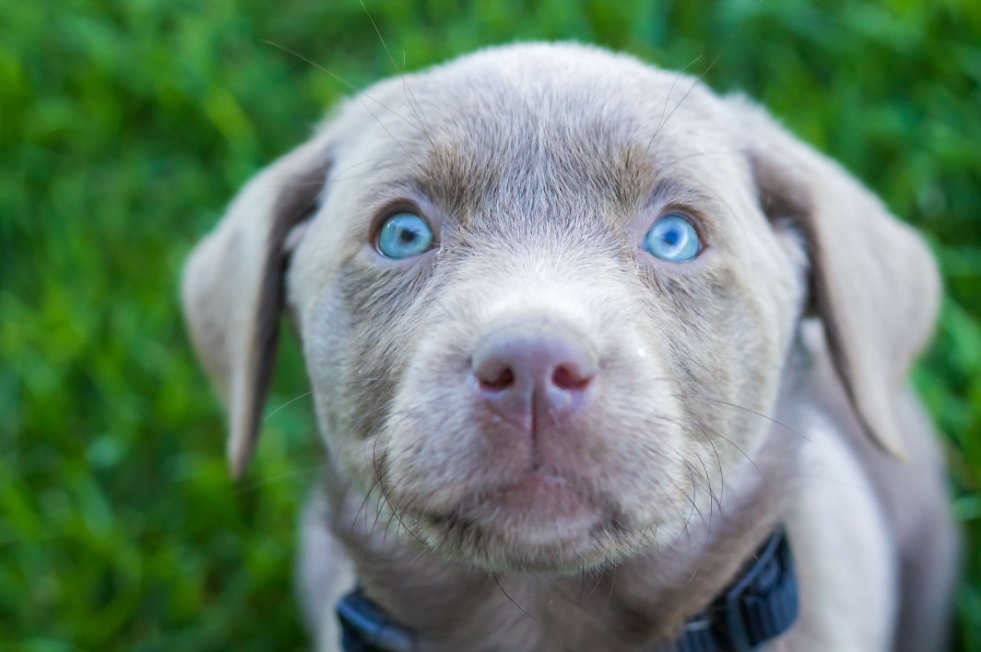Last Updated on July 6, 2023 by Linda Richard
With its distinctive coat color and eye-catching beauty, the Silver Labrador has recently gained popularity among dog lovers. The breed’s origins, however, are a contentious issue that both aficionados and breeders disagree on.

Many people are curious about the origins of Silver Labs and whether they are a distinct breed or only a Labrador Retriever breed variant. Understanding the genetic components that result in the creation of Silver Labs and thinking about the moral ramifications of breeding them is crucial in this situation.
This article will examine the various hypotheses surrounding the genesis of Silver Labs and the breeding techniques employed to create them, stressing both the possible drawbacks and advantages of this method.

Table of Contents
How to get a Silver Labrador puppy?
Here are some steps to think about if you want to purchase a Silver Lab or Silver Labrador Retriever:
- Do your research on breeders of the Silver Labrador. Seek out trustworthy ones who have a track record of producing Silver Labs that are healthy and well-adjusted. You can do this by conducting an online search, requesting referrals from other dog Silver Lab owners, or getting in touch with regional breed groups or organizations.
- Ask for references and look into the credentials of the breeder before buying. Verify their registration, licensing, and adherence to moral breeding methods.
- When you’ve found a possible breeder for Silver Lab, make plans to visit their facilities and meet the dogs there. You will be able to observe the surroundings in which the dogs are raised as well as judge their temperament and general well-being.
- Pose inquiries, and ask the breeder of Silver Labrador questions about their breeding practices, health screenings, socialization programs, and training techniques without hesitation. A trustworthy breeder of the Silver Labrador needs to be open and eager to share information.
- Health testing, confirms that the breeder of Silver Labrador thoroughly examined the parents of the litter for genetic disorders typical of a Silver Labrador Retriever and that they could give proof of these examinations.
- Think about the future, and check the information for the ideal qualities of a Silver Labrador retriever including temperament, health, and other qualities. Ensure the puppies of the Silver Lab have had all necessary vaccines, have been dewormed, and have been socialized.
- Commit, if you come across a Silver Lab puppy that piques your attention, be ready to commit to giving the Silver Lab a home that will be both loving and responsible. Throughout its whole existence, this entails giving the Silver Lab the appropriate nourishment, exercise, training, and veterinary care.
- Contract and paperwork, be careful to sign a contract outlining the terms of the sale, including any health warranties or guarantees, with the breeder of the Silver Lab. Make sure you receive the required documentation, such as registration documents, vaccination records, and health certifications.
- Before bringing your new Silver Lab puppy home, make sure your house is ready with all the things it needs, including a kennel, bed, food, water bowls, toys, and grooming equipment.
- Follow-up. Keep in touch with the Silver Lab breeder and do regular follow-ups to make sure your Silver Lab puppy is settling in well and to ask any questions that may come up.
Additionally, think about joining a neighborhood Labrador Retriever club or organization to meet other owners and other Labs and keep up on breed knowledge.

Things to consider before the production of Silver Lab
There are several crucial elements that breeders should take into account before deciding to create Silver Labs. These consist of:
- Ethics. Since the breeding process can involve selecting dogs based only on their silver color coat rather than their health or working capacity, breeders should think carefully about the ethical implications of creating Silver Labs. Breeders should put the health and welfare of their pets first and abstain from unethical breeding techniques like inbreeding or falsifying genetic tests.
- Health. To lessen the chance of passing the disorders on to their progeny, breeders should thoroughly test their breeding stock for genetic flaws and health issues, such as hip dysplasia, elbow dysplasia, and eye difficulties.
- Demand. Breeders should think about if there are already enough breeders producing Silver Labs in their region or market. Silver Lab overproduction can result in an overabundance of dogs, which is bad for the dogs and bad for the breeders.
- Breed recognition. Breeders should think about whether or not Silver Labs are recognized as a distinct breed by associations like the American Kennel Club, and whether or not this status is significant to them or their potential customers.
- Breed genetic diversity. Breeders should think about whether breeding Silver Labs would boost or diminish the Labrador Retriever breed’s genetic variety and whether this is a desired result.
- Informing. To avoid deceptive marketing or misrepresenting Silver Labs as a different breed, breeders should educate themselves as well as prospective buyers about the nature of Silver Labs, including their origin and any potential health hazards.
- Resources. Breeders should think about whether they have the time, space, and money necessary for socializing and caring for their dogs, as well as for veterinary care and suitable breeding methods.
- Reputation. Breeders should think about how having Silver Labs may affect their standing within the dog breeding industry and whether they are prepared to accept this risk.
Overall, choosing to breed Silver Labs should be a deliberate choice that puts the health and welfare of the canines involved first and weighs the advantages and disadvantages of the breeding process.

Controversy regarding Silver Labs’
Breeders and clubs affiliated with the Association of American Kennel Club now debate the merits of Silver Labradors. Concerns regarding the effects on the health, temperament, and purity of the breed are shared by many breeders.
Despite claims to the contrary, the AKC should not recognize the Silver Labrador Retriever as a true Labrador Retriever since it is a crossbreed. The Silver Labs, according to some opponents and general Labrador Retriever fans, are just a color variant of the breed and should be welcomed as such.
In the end, there has been no clear agreement on what should be done with Silver Labradors, leaving the debate unresolved.
Despite the presence of the dilution gene in the breed, there is no universal agreement regarding Silver Labs, and their position within the Labrador Retriever community remains unclear. While some kennel associations have chosen not to formally recognize them as a distinctive variant of the Labrador Retriever, many have not yet taken a position.

Advantages of Silver Lab production
The ability to produce Silver Labs has several possible benefits:
- They have a distinctive appearance that sets them apart from other Labrador Retrievers.
- Potential health advantages over other Labrador Retriever color variations include a lower risk of skin allergies (however there is no scientific proof to support this claim).
- A greater genetic variety among purebred Labrador Retrievers may help to lower the chance of developing some inherited health problems as a result of inbreeding.
- Popularity among particular breeds of dog owners as a result of their unique appearance.
- Might be used to breed dogs that have desirable qualities, including a pleasant disposition or working prowess.
- Can open up a new area for dog breeders to sell their animals.
- Can perhaps add novel coat hues and patterns to the Labrador Retriever gene pool, which some breeders and pet owners may find appealing.
However, it’s crucial to remember that the benefits of breeding Silver Labs should be evaluated against any hazards and moral dilemmas and that any breeding should put the health and welfare of the dogs involved first.

Disadvantages of Silver Labs’ production
Making Silver Labs could have several drawbacks, including:
- Some breeders contend that breeding Silver Labs only for their coat color, rather than for their health or working aptitude, is unethical because it includes selective breeding. To produce Silver Labs, some breeders have also been known to use unethical breeding techniques, like inbreeding or manipulating genetic testing.
- Health risks. The breeding technique used to create Silver Labs can raise the probability of some genetic flaws and health issues, including hip dysplasia, elbow dysplasia, and eye issues. This is particularly true if breeders don’t thoroughly check their breeding stock for these problems.
- Reduced eligibility for some competitions and events. Because some groups, including the American Kennel Club, do not recognize Silver Labs as a distinct breed, they could not be allowed to participate in some competitions and events.
- Reduced genetic diversity within the Labrador breed. While some breeders contend that the creation of Silver Labs can improve genetic variation within the breed, others contend that the promotion of breeding pups with a certain coat color can reduce diversity.
- Misleading advertising. Some breeders promote Silver Labs as a distinct breed, which may mislead prospective purchasers who are unaware that they are a purebred Labrador Retriever variant.
- Popularity among dishonest breeders. The demand for Silver Labs has increased the number of dishonest breeders that put their financial interests ahead of the health and welfare of their canines. This can result in health difficulties and other problems for both the dogs and their owners.

Although breeding Silver Labs might have certain advantages, it’s vital to carefully assess the risks and moral dilemmas that could arise from this breeding method. Breeders should put their dogs’ health and welfare first and abstain from unethical breeding methods.
Additionally, prospective purchasers should conduct due diligence and engage with reputable breeders who put the health and welfare of their dogs first.

Silver Lab genetics
In terms of breeding dogs, genetics is crucial. Because every dog breed possesses both dominant and recessive features. Breeding is carried out in a very selective manner to transmit particular desirable qualities. Purebred dogs do experience significant inbreeding as a result of this. There are health issues as a result, but we’ll get to those later.
The genetics of dogs are just as complicated and straightforward as those of any other breed.
If you have biology in high school, you are undoubtedly still aware of the concepts of dominant and recessive genes. Brown eyes and blue eyes are frequently used by biology teachers to illustrate this subject simply.

Bb would indicate that someone has brown eyes but bears the trait to pass on blue eyes to his or her children as a possibility since blue eyes are a recessive gene and brown eyes are a dominant gene.
You may or may not pass on blue eyes to your offspring when you have children, depending on the genes your partner carries. Dog genetics functions similarly. A dog must be partnered with a mate who will enable them to effectively pass on that trait if they have a recessive gene for that trait. All dog breeds use this method to pass along their distinctive characteristics.
If you want to know not only how are Silver Labs made, but also about differences between them and Charcoal Labs, please click on the link and read the post.

FAQ
What breeds make up a Silver Lab?
The topic of “Silver Labs” is up for debate in the world of dog breeding. While some breeders contend that Silver Labs are essentially a subset of the Retriever breed, others think that they are an altogether distinct breed.
Those who contend that Silver Labs are a subset of the Retriever breed claim that they were created by mating purebred Labrador Retrievers with diluted coat colors, which is a recessive gene. The dog may have a silver, gray, or even light blue coat as a result of this gene.
Any other Labrador Retriever, including the black, chocolate, and yellow variants, shares the same additional genes that make up a Silver Lab.
The American Kennel Club (AKC) does not, however, classify Silver Labs as a distinct breed. Labradors can only be black, chocolate, silver coat color, or yellow, according to the AKC since there are Yellow Labs, Chocolate Labs, and Black Labs. Their coat color is a result of two recessive genes in the Labrador gene pool.
In the show ring, any other coat color is regarded as disqualifying. It’s crucial to conduct your research and ensure that you’re working with a reputable breeder that values the health and well-being of their pups. Some breeders have begun to sell Silver Labs of the silver color coat as a distinct and distinctive not a mixed breed.
How do you produce a Silver Lab?
The development of a Silver Lab is a contentious subject in the world of dog breeding.
Breeders often cross two Silver Labrador Retrievers with the recessive gene for the diluted silver coat color to obtain Silver Labrador Retrievers. Accordingly, the dilute gene must be present in both parents for Silver color offspring to be born, even if one or both of the parents are black, chocolate, or yellow in hue.
It’s crucial to remember that not all breeders have the same views on the morality of breeding Silver Labs of silver color, and other organizations, like the American Kennel Club, do not recognize Silver Labs as a distinct breed.
To produce Silver Labs, some breeders have also been known to use unethical breeding techniques, like inbreeding or manipulating genetic testing. It’s crucial to conduct research and collaborate with a reputable breeder who has an emphasis on the health and welfare of their canines.
Where did the Silver Labrador come from?
In the world of dog breeding, there is disagreement over whether Silver Labradors are considered to be the purebred breed. Some breeders contend that Silver Labradors are essentially a subset of the Labrador breed, but others think that they are an altogether distinct breed.
Those who contend that Silver Labs are purebred think they were created by mating Labrador Retrievers with a diluted coat color, which is recessively inherited. Dog owners may have a silver, gray, or even light blue coat as a result of this gene.
Any other Labrador Retriever, including the black, chocolate, and yellow variants, shares the same additional genes that make up a Silver Lab.
It’s crucial to remember that some groups, including the American Kennel Club, do not classify Silver Labs as a distinct breed. Labradors can only be black, chocolate, or yellow, according to the AKC. In the show ring, any other coat color is regarded as disqualifying.
Additionally, not all breeders of Silver Lab puppies share the same ethical standards for breeding Silver Labs, and some have even been known to manipulate genetic testing or participate in other unethical breeding techniques to produce Silver Labs and other dogs.
Whether you believe Silver Labs tend to be a purebred breed, it’s crucial to conduct thorough research and work with a reputable breeder of the male silver lab of the purebred dog that places a premium on the health and welfare of their dogs.
What are Chocolate Labs?
A Labrador breed known as a “Chocolate Lab” has a chocolate-brown coat color. Popular dog breeds like Labrador Retrievers or other dogs are renowned for their intelligence, friendliness, and prowess in a variety of tasks like tracking, hunting, and search and rescue.
Along with black yellow and chocolate, the Chocolate Lab is one of the three standard coat colors for Labrador Retrievers, not other dogs. The breed is well-known as a working and companion dog, and the Chocolate Lab in particular is renowned for its kind and amiable nature.
In addition, the Labrador breed known as the “Yellow Lab” has a coat that can range in color from light cream to a deep golden shade. The Labrador breed comes in two main coat color varieties, black and Yellow Labs.
How to train Silver Labs?
The most effective training method for all dogs, not just Labs, is positive reinforcement. This implies that good behavior is rewarded with food, gifts, or attention. Due to their enormous hunger, sweets will be their preferred form of reward.
Due to their high level of intelligence, Labradors will thoroughly enjoy their training sessions. The key components for any effective training are repetition and consistency.
They are quite intelligent, which makes it easy for them to become bored. When you train them, you give them tons of mental stimulus to keep them busy.
Fetch is a fun activity to keep your dog busy. This can be done in back gardens or while taking safe walks. It enables them to use a lot of energy while requiring little effort from you. To avoid any awkward circumstances if your dog is off-leash, make sure they have a strong recall.
Labradors are amiable dogs by nature. When they are young, be careful to introduce them to lots of people because they love being around others. It’s also crucial for dogs to socialize with one another. Any young puppies can benefit from being socialized at puppy parties.
Are Silver Labs suitable for families?
Silver Labs are wonderful family pets. They are affable, loving, and loyal to their people. In addition to being excellent family pets, Silver Labs are also highly intelligent and simple to teach, making them the ideal addition to any agility or obedience programs. They may even be employed as service or therapy dogs.
Additionally, Silver Labs are highly spirited and enjoy being active. They are perfect for owners who lead active lifestyles because they require a lot of mental and physical stimulation. You can depend on them to be a furry member of your family because they get along well with kids and even your other pets.
A Silver Lab’s size and energy level are the only things to be on the lookout for, which means they might not be the greatest choice for an apartment or other compact area.
Conclusion
In the realm of dog breeding, the genesis of Silver Labs is a complex and debatable subject. Some breeders of dog breeds and dog owners contend that they are merely a subset of the Retriever breed, whilst others think they are an entirely different breed.
Regardless of their classification, it is known that Labrador Retrievers with a recessive gene for diluted coat color are bred together to generate Silver Labs. The ethics of breeding Silver Labs are a contentious issue among breeders, and some organizations do not even recognize them as a distinct breeds.

As with any breed, it’s critical to conduct thorough research and engage with a reputable breeder who places a high priority on the health and welfare of their canines and who is open and honest about their breeding techniques.
I hope this information was useful to you and you seriously thought about whether this breed is right for you. I will be glad to any questions on this topic in the comments.
Would you like to learn more information on how are Silver Labs made? Just follow the link and read the article.
Read more about What color Labrador is most expensive: a complete guide


